Investigating Value Chain Strategy Making in Taiwan High Tech Company
VerifiedAdded on 2020/01/23
|10
|4074
|117
Report
AI Summary
This report presents a research methodology for investigating the value chain of strategy making in a Taiwan High Tech company. It outlines the research philosophy, approach, and design, with a focus on positivism and an inductive approach. The study employs a descriptive research design and utilizes both primary and secondary data collection methods, including questionnaires and literature reviews. The report details the sampling techniques, data analysis procedures, and considerations for reliability, validity, and ethical concerns. The methodology aims to provide a structured framework for understanding how strategy is developed and implemented within the context of a high-tech firm in Taiwan, contributing to the overall understanding of value chain dynamics and strategic decision-making processes.
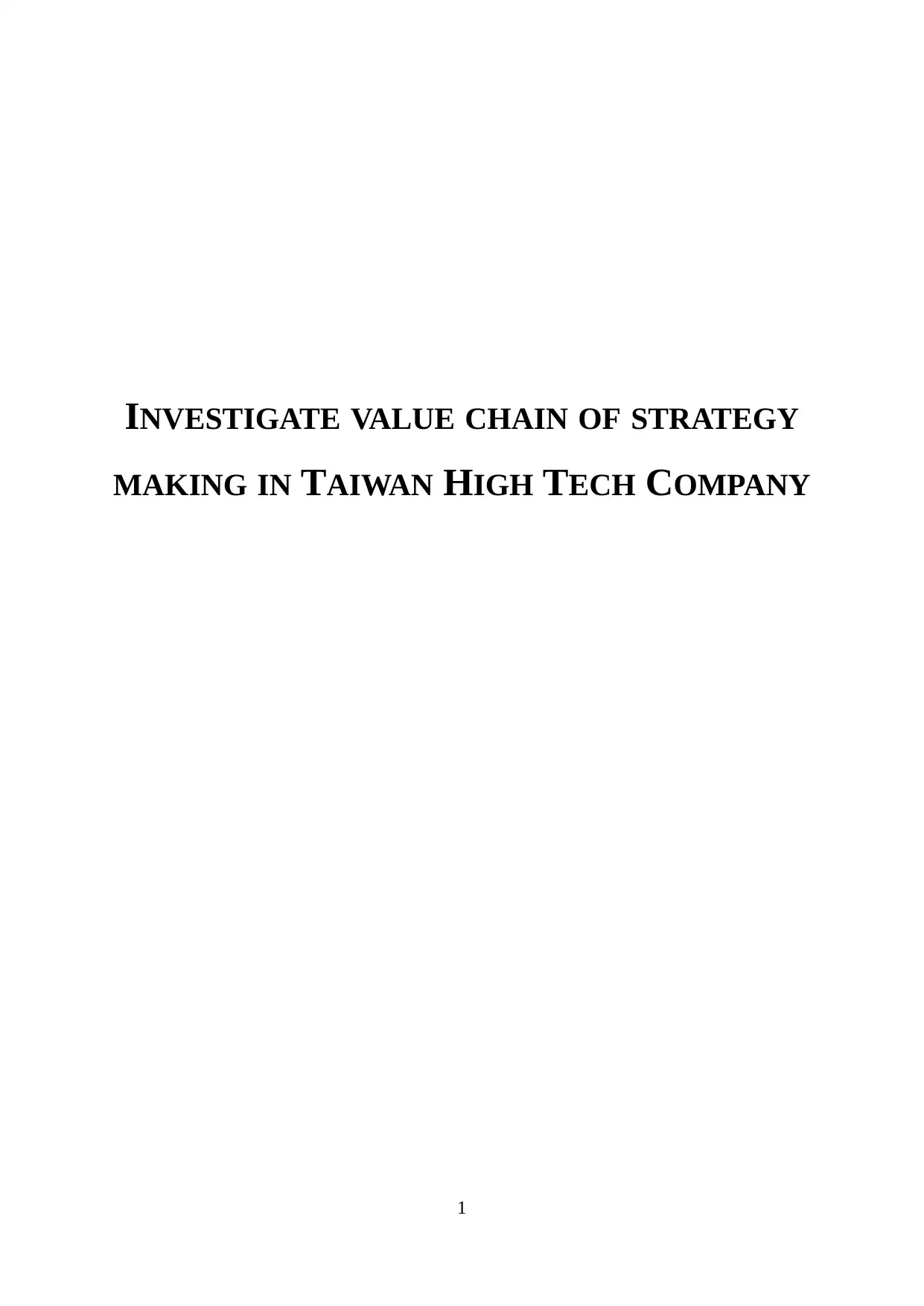
INVESTIGATE VALUE CHAIN OF STRATEGY
MAKING IN TAIWAN HIGH TECH COMPANY
1
MAKING IN TAIWAN HIGH TECH COMPANY
1
Paraphrase This Document
Need a fresh take? Get an instant paraphrase of this document with our AI Paraphraser
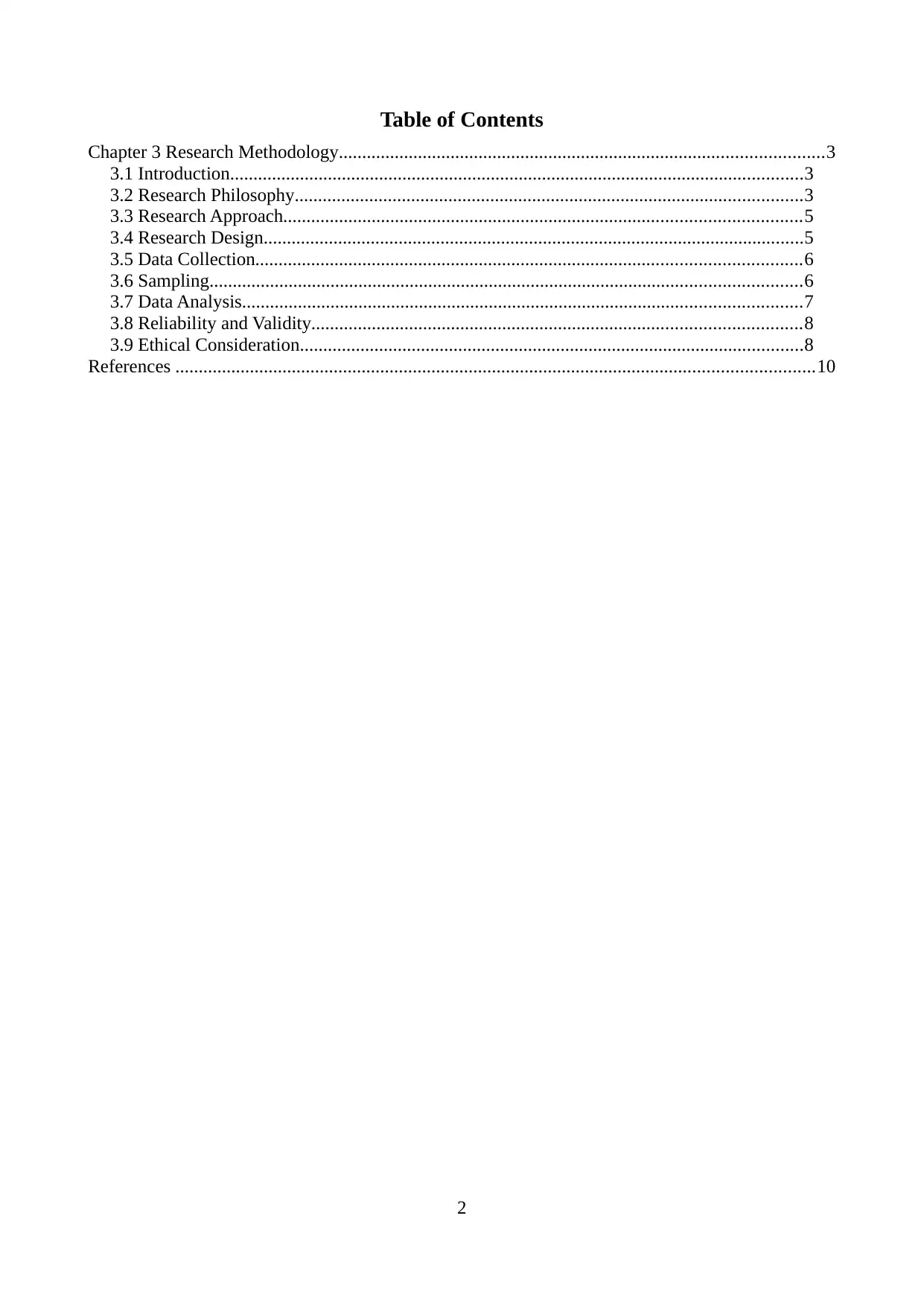
Table of Contents
Chapter 3 Research Methodology........................................................................................................3
3.1 Introduction...........................................................................................................................3
3.2 Research Philosophy.............................................................................................................3
3.3 Research Approach...............................................................................................................5
3.4 Research Design....................................................................................................................5
3.5 Data Collection.....................................................................................................................6
3.6 Sampling...............................................................................................................................6
3.7 Data Analysis........................................................................................................................7
3.8 Reliability and Validity.........................................................................................................8
3.9 Ethical Consideration............................................................................................................8
References .........................................................................................................................................10
2
Chapter 3 Research Methodology........................................................................................................3
3.1 Introduction...........................................................................................................................3
3.2 Research Philosophy.............................................................................................................3
3.3 Research Approach...............................................................................................................5
3.4 Research Design....................................................................................................................5
3.5 Data Collection.....................................................................................................................6
3.6 Sampling...............................................................................................................................6
3.7 Data Analysis........................................................................................................................7
3.8 Reliability and Validity.........................................................................................................8
3.9 Ethical Consideration............................................................................................................8
References .........................................................................................................................................10
2
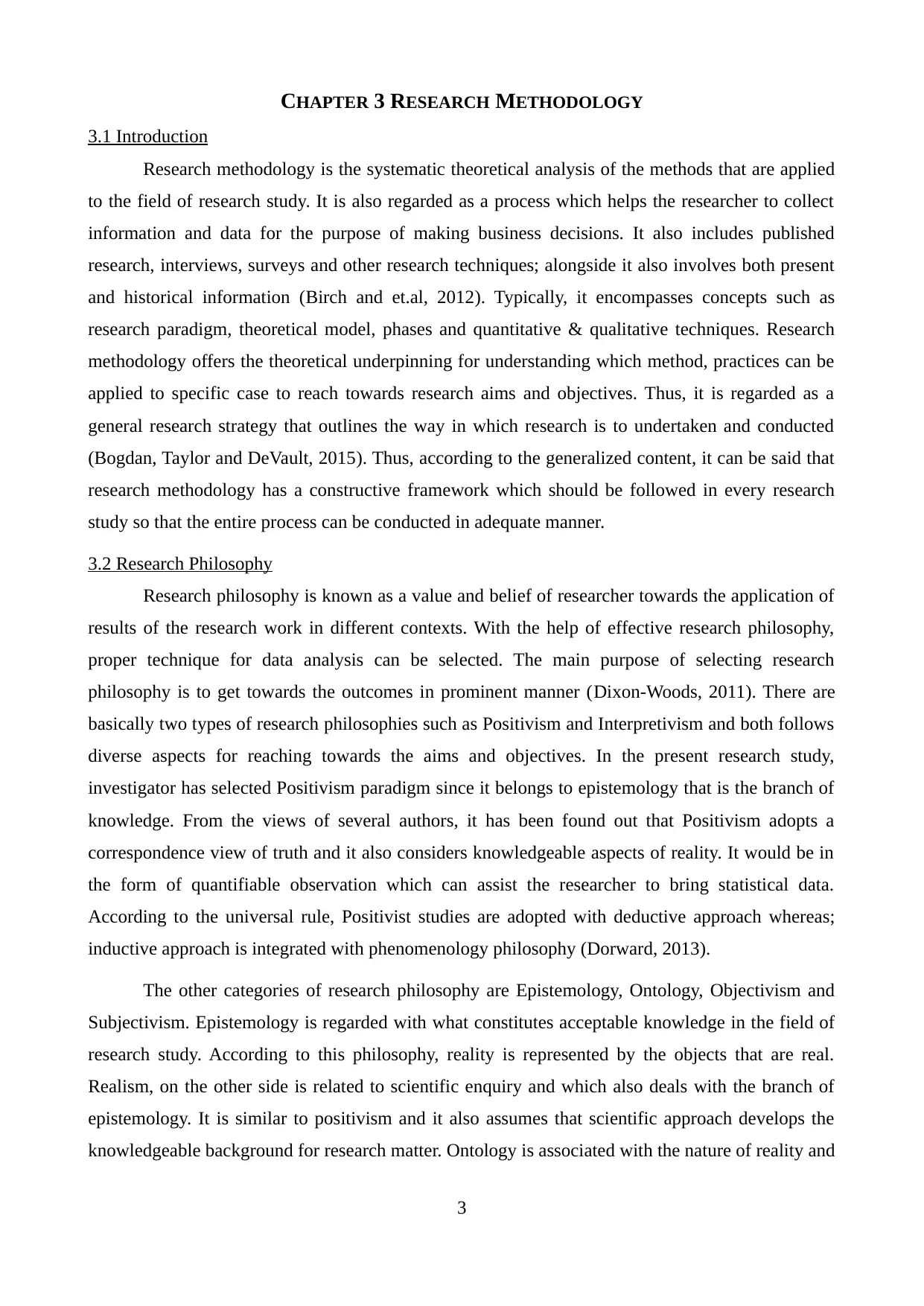
CHAPTER 3 RESEARCH METHODOLOGY
3.1 Introduction
Research methodology is the systematic theoretical analysis of the methods that are applied
to the field of research study. It is also regarded as a process which helps the researcher to collect
information and data for the purpose of making business decisions. It also includes published
research, interviews, surveys and other research techniques; alongside it also involves both present
and historical information (Birch and et.al, 2012). Typically, it encompasses concepts such as
research paradigm, theoretical model, phases and quantitative & qualitative techniques. Research
methodology offers the theoretical underpinning for understanding which method, practices can be
applied to specific case to reach towards research aims and objectives. Thus, it is regarded as a
general research strategy that outlines the way in which research is to undertaken and conducted
(Bogdan, Taylor and DeVault, 2015). Thus, according to the generalized content, it can be said that
research methodology has a constructive framework which should be followed in every research
study so that the entire process can be conducted in adequate manner.
3.2 Research Philosophy
Research philosophy is known as a value and belief of researcher towards the application of
results of the research work in different contexts. With the help of effective research philosophy,
proper technique for data analysis can be selected. The main purpose of selecting research
philosophy is to get towards the outcomes in prominent manner (Dixon-Woods, 2011). There are
basically two types of research philosophies such as Positivism and Interpretivism and both follows
diverse aspects for reaching towards the aims and objectives. In the present research study,
investigator has selected Positivism paradigm since it belongs to epistemology that is the branch of
knowledge. From the views of several authors, it has been found out that Positivism adopts a
correspondence view of truth and it also considers knowledgeable aspects of reality. It would be in
the form of quantifiable observation which can assist the researcher to bring statistical data.
According to the universal rule, Positivist studies are adopted with deductive approach whereas;
inductive approach is integrated with phenomenology philosophy (Dorward, 2013).
The other categories of research philosophy are Epistemology, Ontology, Objectivism and
Subjectivism. Epistemology is regarded with what constitutes acceptable knowledge in the field of
research study. According to this philosophy, reality is represented by the objects that are real.
Realism, on the other side is related to scientific enquiry and which also deals with the branch of
epistemology. It is similar to positivism and it also assumes that scientific approach develops the
knowledgeable background for research matter. Ontology is associated with the nature of reality and
3
3.1 Introduction
Research methodology is the systematic theoretical analysis of the methods that are applied
to the field of research study. It is also regarded as a process which helps the researcher to collect
information and data for the purpose of making business decisions. It also includes published
research, interviews, surveys and other research techniques; alongside it also involves both present
and historical information (Birch and et.al, 2012). Typically, it encompasses concepts such as
research paradigm, theoretical model, phases and quantitative & qualitative techniques. Research
methodology offers the theoretical underpinning for understanding which method, practices can be
applied to specific case to reach towards research aims and objectives. Thus, it is regarded as a
general research strategy that outlines the way in which research is to undertaken and conducted
(Bogdan, Taylor and DeVault, 2015). Thus, according to the generalized content, it can be said that
research methodology has a constructive framework which should be followed in every research
study so that the entire process can be conducted in adequate manner.
3.2 Research Philosophy
Research philosophy is known as a value and belief of researcher towards the application of
results of the research work in different contexts. With the help of effective research philosophy,
proper technique for data analysis can be selected. The main purpose of selecting research
philosophy is to get towards the outcomes in prominent manner (Dixon-Woods, 2011). There are
basically two types of research philosophies such as Positivism and Interpretivism and both follows
diverse aspects for reaching towards the aims and objectives. In the present research study,
investigator has selected Positivism paradigm since it belongs to epistemology that is the branch of
knowledge. From the views of several authors, it has been found out that Positivism adopts a
correspondence view of truth and it also considers knowledgeable aspects of reality. It would be in
the form of quantifiable observation which can assist the researcher to bring statistical data.
According to the universal rule, Positivist studies are adopted with deductive approach whereas;
inductive approach is integrated with phenomenology philosophy (Dorward, 2013).
The other categories of research philosophy are Epistemology, Ontology, Objectivism and
Subjectivism. Epistemology is regarded with what constitutes acceptable knowledge in the field of
research study. According to this philosophy, reality is represented by the objects that are real.
Realism, on the other side is related to scientific enquiry and which also deals with the branch of
epistemology. It is similar to positivism and it also assumes that scientific approach develops the
knowledgeable background for research matter. Ontology is associated with the nature of reality and
3
⊘ This is a preview!⊘
Do you want full access?
Subscribe today to unlock all pages.

Trusted by 1+ million students worldwide
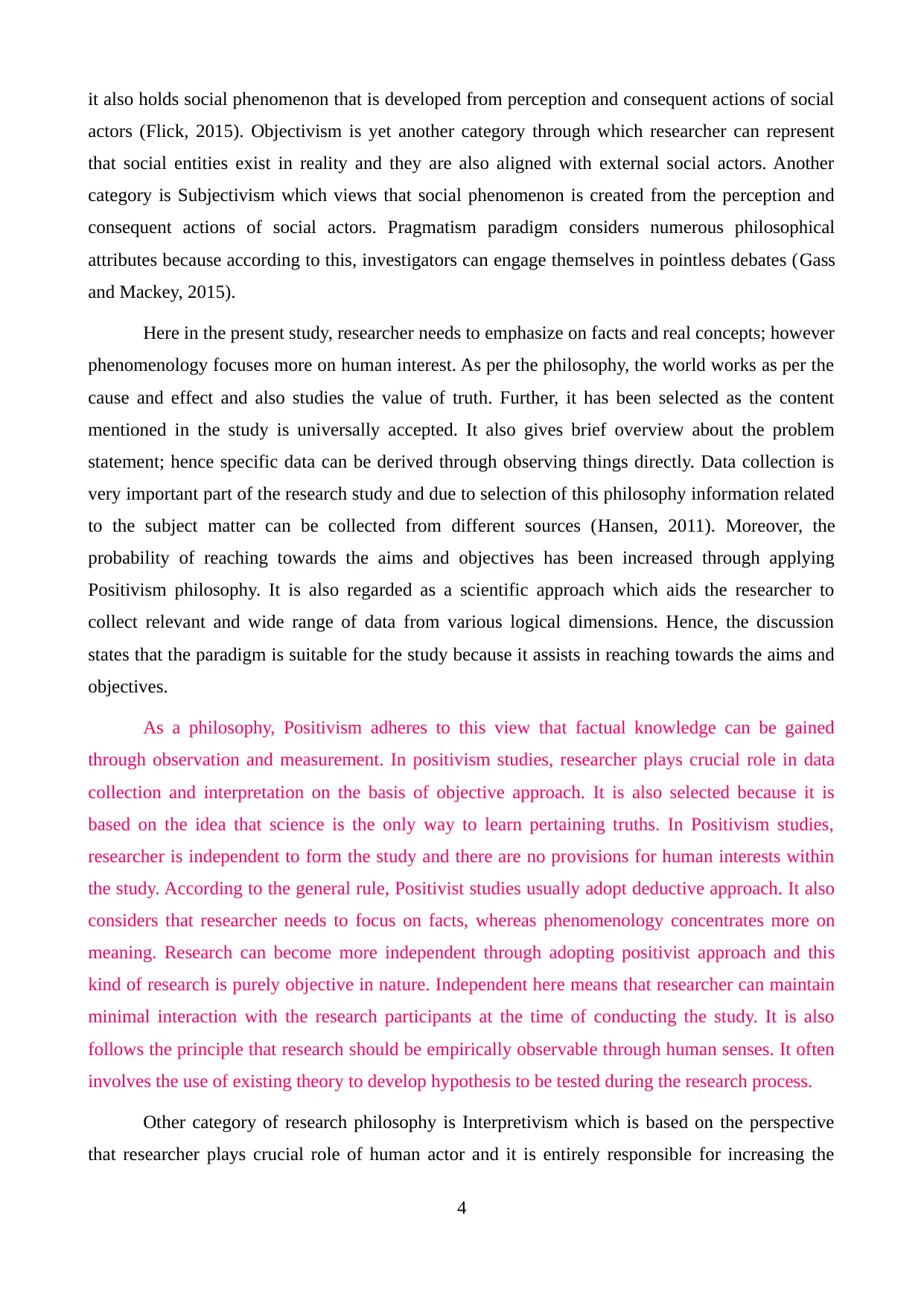
it also holds social phenomenon that is developed from perception and consequent actions of social
actors (Flick, 2015). Objectivism is yet another category through which researcher can represent
that social entities exist in reality and they are also aligned with external social actors. Another
category is Subjectivism which views that social phenomenon is created from the perception and
consequent actions of social actors. Pragmatism paradigm considers numerous philosophical
attributes because according to this, investigators can engage themselves in pointless debates (Gass
and Mackey, 2015).
Here in the present study, researcher needs to emphasize on facts and real concepts; however
phenomenology focuses more on human interest. As per the philosophy, the world works as per the
cause and effect and also studies the value of truth. Further, it has been selected as the content
mentioned in the study is universally accepted. It also gives brief overview about the problem
statement; hence specific data can be derived through observing things directly. Data collection is
very important part of the research study and due to selection of this philosophy information related
to the subject matter can be collected from different sources (Hansen, 2011). Moreover, the
probability of reaching towards the aims and objectives has been increased through applying
Positivism philosophy. It is also regarded as a scientific approach which aids the researcher to
collect relevant and wide range of data from various logical dimensions. Hence, the discussion
states that the paradigm is suitable for the study because it assists in reaching towards the aims and
objectives.
As a philosophy, Positivism adheres to this view that factual knowledge can be gained
through observation and measurement. In positivism studies, researcher plays crucial role in data
collection and interpretation on the basis of objective approach. It is also selected because it is
based on the idea that science is the only way to learn pertaining truths. In Positivism studies,
researcher is independent to form the study and there are no provisions for human interests within
the study. According to the general rule, Positivist studies usually adopt deductive approach. It also
considers that researcher needs to focus on facts, whereas phenomenology concentrates more on
meaning. Research can become more independent through adopting positivist approach and this
kind of research is purely objective in nature. Independent here means that researcher can maintain
minimal interaction with the research participants at the time of conducting the study. It is also
follows the principle that research should be empirically observable through human senses. It often
involves the use of existing theory to develop hypothesis to be tested during the research process.
Other category of research philosophy is Interpretivism which is based on the perspective
that researcher plays crucial role of human actor and it is entirely responsible for increasing the
4
actors (Flick, 2015). Objectivism is yet another category through which researcher can represent
that social entities exist in reality and they are also aligned with external social actors. Another
category is Subjectivism which views that social phenomenon is created from the perception and
consequent actions of social actors. Pragmatism paradigm considers numerous philosophical
attributes because according to this, investigators can engage themselves in pointless debates (Gass
and Mackey, 2015).
Here in the present study, researcher needs to emphasize on facts and real concepts; however
phenomenology focuses more on human interest. As per the philosophy, the world works as per the
cause and effect and also studies the value of truth. Further, it has been selected as the content
mentioned in the study is universally accepted. It also gives brief overview about the problem
statement; hence specific data can be derived through observing things directly. Data collection is
very important part of the research study and due to selection of this philosophy information related
to the subject matter can be collected from different sources (Hansen, 2011). Moreover, the
probability of reaching towards the aims and objectives has been increased through applying
Positivism philosophy. It is also regarded as a scientific approach which aids the researcher to
collect relevant and wide range of data from various logical dimensions. Hence, the discussion
states that the paradigm is suitable for the study because it assists in reaching towards the aims and
objectives.
As a philosophy, Positivism adheres to this view that factual knowledge can be gained
through observation and measurement. In positivism studies, researcher plays crucial role in data
collection and interpretation on the basis of objective approach. It is also selected because it is
based on the idea that science is the only way to learn pertaining truths. In Positivism studies,
researcher is independent to form the study and there are no provisions for human interests within
the study. According to the general rule, Positivist studies usually adopt deductive approach. It also
considers that researcher needs to focus on facts, whereas phenomenology concentrates more on
meaning. Research can become more independent through adopting positivist approach and this
kind of research is purely objective in nature. Independent here means that researcher can maintain
minimal interaction with the research participants at the time of conducting the study. It is also
follows the principle that research should be empirically observable through human senses. It often
involves the use of existing theory to develop hypothesis to be tested during the research process.
Other category of research philosophy is Interpretivism which is based on the perspective
that researcher plays crucial role of human actor and it is entirely responsible for increasing the
4
Paraphrase This Document
Need a fresh take? Get an instant paraphrase of this document with our AI Paraphraser
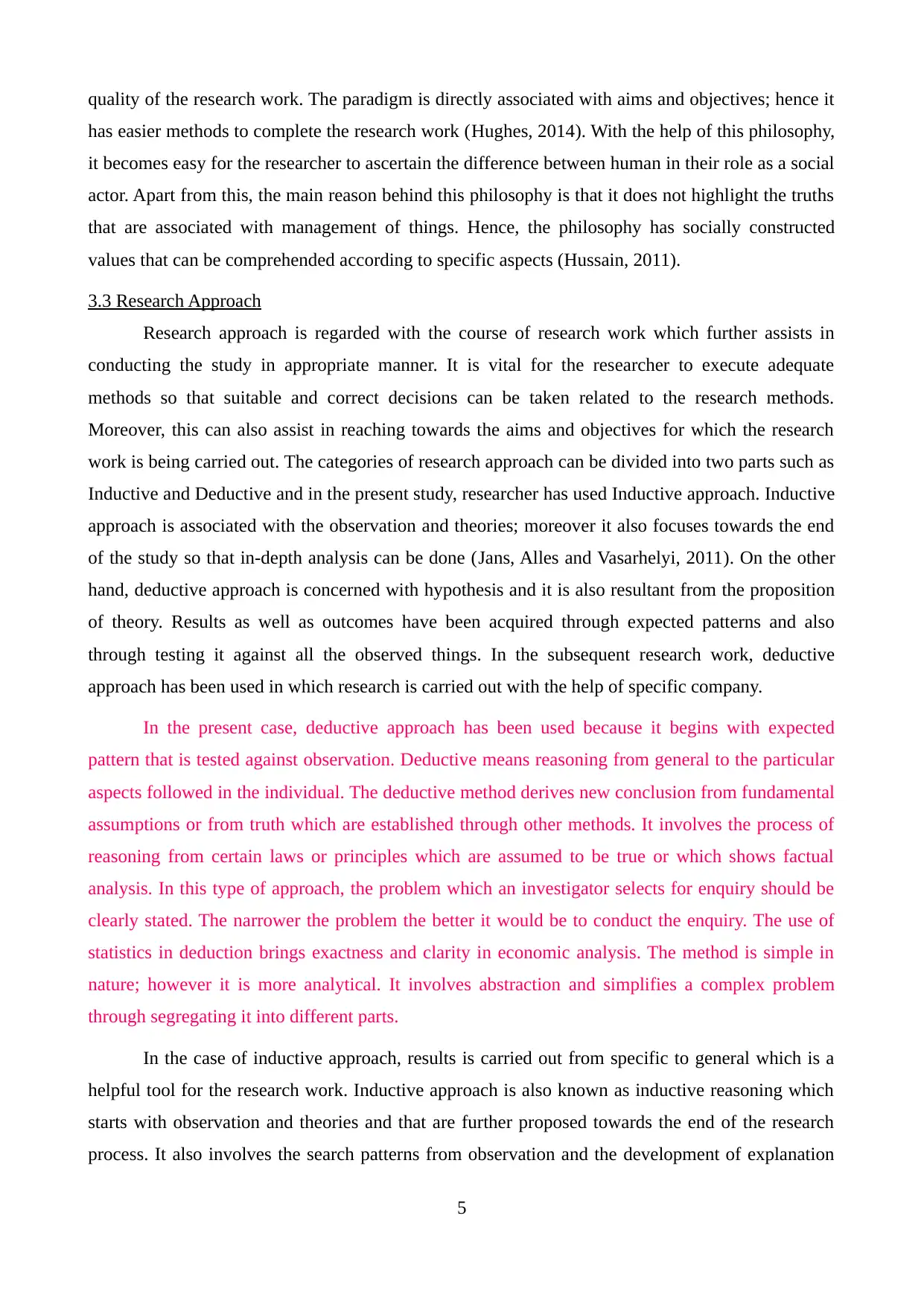
quality of the research work. The paradigm is directly associated with aims and objectives; hence it
has easier methods to complete the research work (Hughes, 2014). With the help of this philosophy,
it becomes easy for the researcher to ascertain the difference between human in their role as a social
actor. Apart from this, the main reason behind this philosophy is that it does not highlight the truths
that are associated with management of things. Hence, the philosophy has socially constructed
values that can be comprehended according to specific aspects (Hussain, 2011).
3.3 Research Approach
Research approach is regarded with the course of research work which further assists in
conducting the study in appropriate manner. It is vital for the researcher to execute adequate
methods so that suitable and correct decisions can be taken related to the research methods.
Moreover, this can also assist in reaching towards the aims and objectives for which the research
work is being carried out. The categories of research approach can be divided into two parts such as
Inductive and Deductive and in the present study, researcher has used Inductive approach. Inductive
approach is associated with the observation and theories; moreover it also focuses towards the end
of the study so that in-depth analysis can be done (Jans, Alles and Vasarhelyi, 2011). On the other
hand, deductive approach is concerned with hypothesis and it is also resultant from the proposition
of theory. Results as well as outcomes have been acquired through expected patterns and also
through testing it against all the observed things. In the subsequent research work, deductive
approach has been used in which research is carried out with the help of specific company.
In the present case, deductive approach has been used because it begins with expected
pattern that is tested against observation. Deductive means reasoning from general to the particular
aspects followed in the individual. The deductive method derives new conclusion from fundamental
assumptions or from truth which are established through other methods. It involves the process of
reasoning from certain laws or principles which are assumed to be true or which shows factual
analysis. In this type of approach, the problem which an investigator selects for enquiry should be
clearly stated. The narrower the problem the better it would be to conduct the enquiry. The use of
statistics in deduction brings exactness and clarity in economic analysis. The method is simple in
nature; however it is more analytical. It involves abstraction and simplifies a complex problem
through segregating it into different parts.
In the case of inductive approach, results is carried out from specific to general which is a
helpful tool for the research work. Inductive approach is also known as inductive reasoning which
starts with observation and theories and that are further proposed towards the end of the research
process. It also involves the search patterns from observation and the development of explanation
5
has easier methods to complete the research work (Hughes, 2014). With the help of this philosophy,
it becomes easy for the researcher to ascertain the difference between human in their role as a social
actor. Apart from this, the main reason behind this philosophy is that it does not highlight the truths
that are associated with management of things. Hence, the philosophy has socially constructed
values that can be comprehended according to specific aspects (Hussain, 2011).
3.3 Research Approach
Research approach is regarded with the course of research work which further assists in
conducting the study in appropriate manner. It is vital for the researcher to execute adequate
methods so that suitable and correct decisions can be taken related to the research methods.
Moreover, this can also assist in reaching towards the aims and objectives for which the research
work is being carried out. The categories of research approach can be divided into two parts such as
Inductive and Deductive and in the present study, researcher has used Inductive approach. Inductive
approach is associated with the observation and theories; moreover it also focuses towards the end
of the study so that in-depth analysis can be done (Jans, Alles and Vasarhelyi, 2011). On the other
hand, deductive approach is concerned with hypothesis and it is also resultant from the proposition
of theory. Results as well as outcomes have been acquired through expected patterns and also
through testing it against all the observed things. In the subsequent research work, deductive
approach has been used in which research is carried out with the help of specific company.
In the present case, deductive approach has been used because it begins with expected
pattern that is tested against observation. Deductive means reasoning from general to the particular
aspects followed in the individual. The deductive method derives new conclusion from fundamental
assumptions or from truth which are established through other methods. It involves the process of
reasoning from certain laws or principles which are assumed to be true or which shows factual
analysis. In this type of approach, the problem which an investigator selects for enquiry should be
clearly stated. The narrower the problem the better it would be to conduct the enquiry. The use of
statistics in deduction brings exactness and clarity in economic analysis. The method is simple in
nature; however it is more analytical. It involves abstraction and simplifies a complex problem
through segregating it into different parts.
In the case of inductive approach, results is carried out from specific to general which is a
helpful tool for the research work. Inductive approach is also known as inductive reasoning which
starts with observation and theories and that are further proposed towards the end of the research
process. It also involves the search patterns from observation and the development of explanation
5
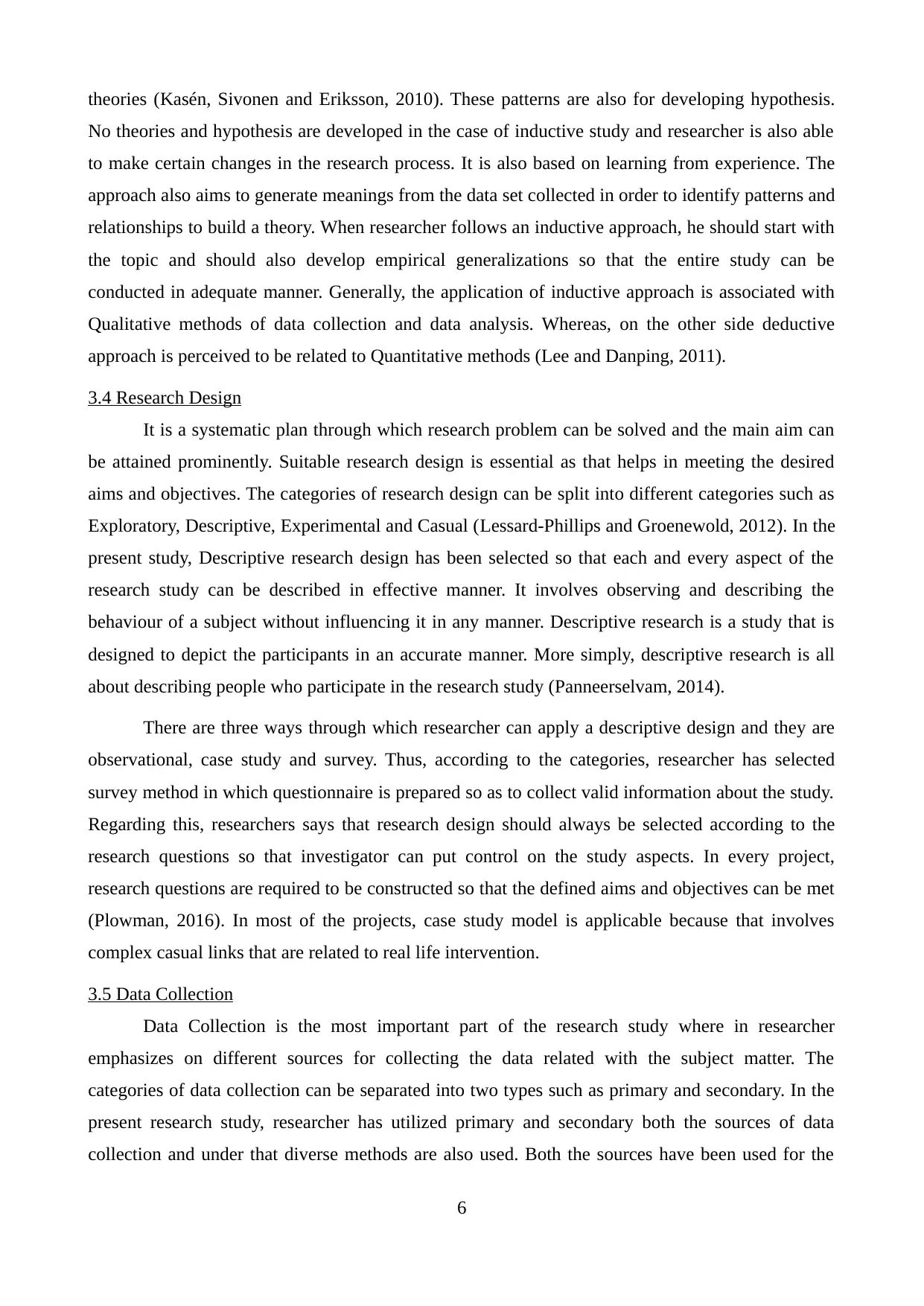
theories (Kasén, Sivonen and Eriksson, 2010). These patterns are also for developing hypothesis.
No theories and hypothesis are developed in the case of inductive study and researcher is also able
to make certain changes in the research process. It is also based on learning from experience. The
approach also aims to generate meanings from the data set collected in order to identify patterns and
relationships to build a theory. When researcher follows an inductive approach, he should start with
the topic and should also develop empirical generalizations so that the entire study can be
conducted in adequate manner. Generally, the application of inductive approach is associated with
Qualitative methods of data collection and data analysis. Whereas, on the other side deductive
approach is perceived to be related to Quantitative methods (Lee and Danping, 2011).
3.4 Research Design
It is a systematic plan through which research problem can be solved and the main aim can
be attained prominently. Suitable research design is essential as that helps in meeting the desired
aims and objectives. The categories of research design can be split into different categories such as
Exploratory, Descriptive, Experimental and Casual (Lessard-Phillips and Groenewold, 2012). In the
present study, Descriptive research design has been selected so that each and every aspect of the
research study can be described in effective manner. It involves observing and describing the
behaviour of a subject without influencing it in any manner. Descriptive research is a study that is
designed to depict the participants in an accurate manner. More simply, descriptive research is all
about describing people who participate in the research study (Panneerselvam, 2014).
There are three ways through which researcher can apply a descriptive design and they are
observational, case study and survey. Thus, according to the categories, researcher has selected
survey method in which questionnaire is prepared so as to collect valid information about the study.
Regarding this, researchers says that research design should always be selected according to the
research questions so that investigator can put control on the study aspects. In every project,
research questions are required to be constructed so that the defined aims and objectives can be met
(Plowman, 2016). In most of the projects, case study model is applicable because that involves
complex casual links that are related to real life intervention.
3.5 Data Collection
Data Collection is the most important part of the research study where in researcher
emphasizes on different sources for collecting the data related with the subject matter. The
categories of data collection can be separated into two types such as primary and secondary. In the
present research study, researcher has utilized primary and secondary both the sources of data
collection and under that diverse methods are also used. Both the sources have been used for the
6
No theories and hypothesis are developed in the case of inductive study and researcher is also able
to make certain changes in the research process. It is also based on learning from experience. The
approach also aims to generate meanings from the data set collected in order to identify patterns and
relationships to build a theory. When researcher follows an inductive approach, he should start with
the topic and should also develop empirical generalizations so that the entire study can be
conducted in adequate manner. Generally, the application of inductive approach is associated with
Qualitative methods of data collection and data analysis. Whereas, on the other side deductive
approach is perceived to be related to Quantitative methods (Lee and Danping, 2011).
3.4 Research Design
It is a systematic plan through which research problem can be solved and the main aim can
be attained prominently. Suitable research design is essential as that helps in meeting the desired
aims and objectives. The categories of research design can be split into different categories such as
Exploratory, Descriptive, Experimental and Casual (Lessard-Phillips and Groenewold, 2012). In the
present study, Descriptive research design has been selected so that each and every aspect of the
research study can be described in effective manner. It involves observing and describing the
behaviour of a subject without influencing it in any manner. Descriptive research is a study that is
designed to depict the participants in an accurate manner. More simply, descriptive research is all
about describing people who participate in the research study (Panneerselvam, 2014).
There are three ways through which researcher can apply a descriptive design and they are
observational, case study and survey. Thus, according to the categories, researcher has selected
survey method in which questionnaire is prepared so as to collect valid information about the study.
Regarding this, researchers says that research design should always be selected according to the
research questions so that investigator can put control on the study aspects. In every project,
research questions are required to be constructed so that the defined aims and objectives can be met
(Plowman, 2016). In most of the projects, case study model is applicable because that involves
complex casual links that are related to real life intervention.
3.5 Data Collection
Data Collection is the most important part of the research study where in researcher
emphasizes on different sources for collecting the data related with the subject matter. The
categories of data collection can be separated into two types such as primary and secondary. In the
present research study, researcher has utilized primary and secondary both the sources of data
collection and under that diverse methods are also used. Both the sources have been used for the
6
⊘ This is a preview!⊘
Do you want full access?
Subscribe today to unlock all pages.

Trusted by 1+ million students worldwide
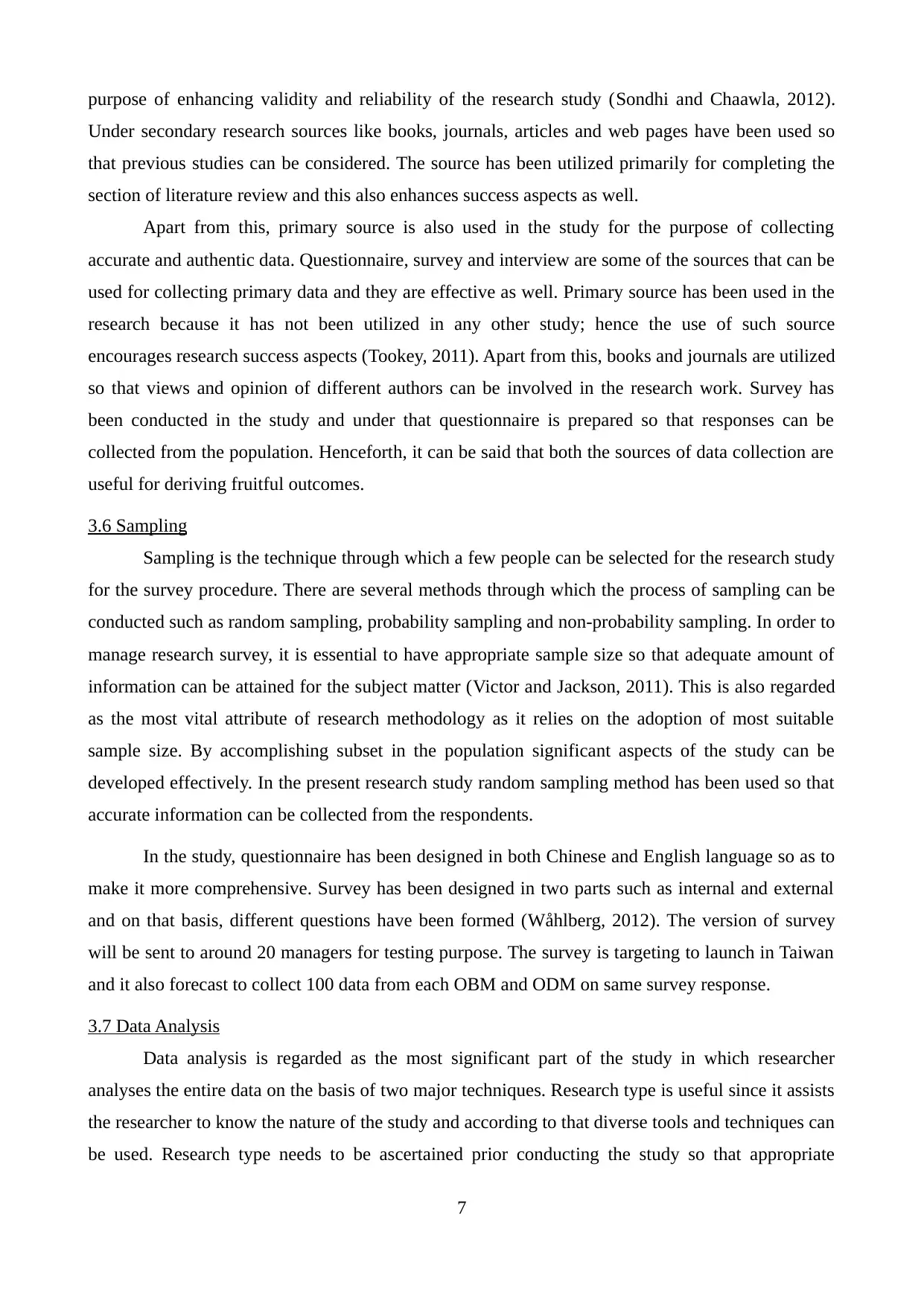
purpose of enhancing validity and reliability of the research study (Sondhi and Chaawla, 2012).
Under secondary research sources like books, journals, articles and web pages have been used so
that previous studies can be considered. The source has been utilized primarily for completing the
section of literature review and this also enhances success aspects as well.
Apart from this, primary source is also used in the study for the purpose of collecting
accurate and authentic data. Questionnaire, survey and interview are some of the sources that can be
used for collecting primary data and they are effective as well. Primary source has been used in the
research because it has not been utilized in any other study; hence the use of such source
encourages research success aspects (Tookey, 2011). Apart from this, books and journals are utilized
so that views and opinion of different authors can be involved in the research work. Survey has
been conducted in the study and under that questionnaire is prepared so that responses can be
collected from the population. Henceforth, it can be said that both the sources of data collection are
useful for deriving fruitful outcomes.
3.6 Sampling
Sampling is the technique through which a few people can be selected for the research study
for the survey procedure. There are several methods through which the process of sampling can be
conducted such as random sampling, probability sampling and non-probability sampling. In order to
manage research survey, it is essential to have appropriate sample size so that adequate amount of
information can be attained for the subject matter (Victor and Jackson, 2011). This is also regarded
as the most vital attribute of research methodology as it relies on the adoption of most suitable
sample size. By accomplishing subset in the population significant aspects of the study can be
developed effectively. In the present research study random sampling method has been used so that
accurate information can be collected from the respondents.
In the study, questionnaire has been designed in both Chinese and English language so as to
make it more comprehensive. Survey has been designed in two parts such as internal and external
and on that basis, different questions have been formed (Wåhlberg, 2012). The version of survey
will be sent to around 20 managers for testing purpose. The survey is targeting to launch in Taiwan
and it also forecast to collect 100 data from each OBM and ODM on same survey response.
3.7 Data Analysis
Data analysis is regarded as the most significant part of the study in which researcher
analyses the entire data on the basis of two major techniques. Research type is useful since it assists
the researcher to know the nature of the study and according to that diverse tools and techniques can
be used. Research type needs to be ascertained prior conducting the study so that appropriate
7
Under secondary research sources like books, journals, articles and web pages have been used so
that previous studies can be considered. The source has been utilized primarily for completing the
section of literature review and this also enhances success aspects as well.
Apart from this, primary source is also used in the study for the purpose of collecting
accurate and authentic data. Questionnaire, survey and interview are some of the sources that can be
used for collecting primary data and they are effective as well. Primary source has been used in the
research because it has not been utilized in any other study; hence the use of such source
encourages research success aspects (Tookey, 2011). Apart from this, books and journals are utilized
so that views and opinion of different authors can be involved in the research work. Survey has
been conducted in the study and under that questionnaire is prepared so that responses can be
collected from the population. Henceforth, it can be said that both the sources of data collection are
useful for deriving fruitful outcomes.
3.6 Sampling
Sampling is the technique through which a few people can be selected for the research study
for the survey procedure. There are several methods through which the process of sampling can be
conducted such as random sampling, probability sampling and non-probability sampling. In order to
manage research survey, it is essential to have appropriate sample size so that adequate amount of
information can be attained for the subject matter (Victor and Jackson, 2011). This is also regarded
as the most vital attribute of research methodology as it relies on the adoption of most suitable
sample size. By accomplishing subset in the population significant aspects of the study can be
developed effectively. In the present research study random sampling method has been used so that
accurate information can be collected from the respondents.
In the study, questionnaire has been designed in both Chinese and English language so as to
make it more comprehensive. Survey has been designed in two parts such as internal and external
and on that basis, different questions have been formed (Wåhlberg, 2012). The version of survey
will be sent to around 20 managers for testing purpose. The survey is targeting to launch in Taiwan
and it also forecast to collect 100 data from each OBM and ODM on same survey response.
3.7 Data Analysis
Data analysis is regarded as the most significant part of the study in which researcher
analyses the entire data on the basis of two major techniques. Research type is useful since it assists
the researcher to know the nature of the study and according to that diverse tools and techniques can
be used. Research type needs to be ascertained prior conducting the study so that appropriate
7
Paraphrase This Document
Need a fresh take? Get an instant paraphrase of this document with our AI Paraphraser
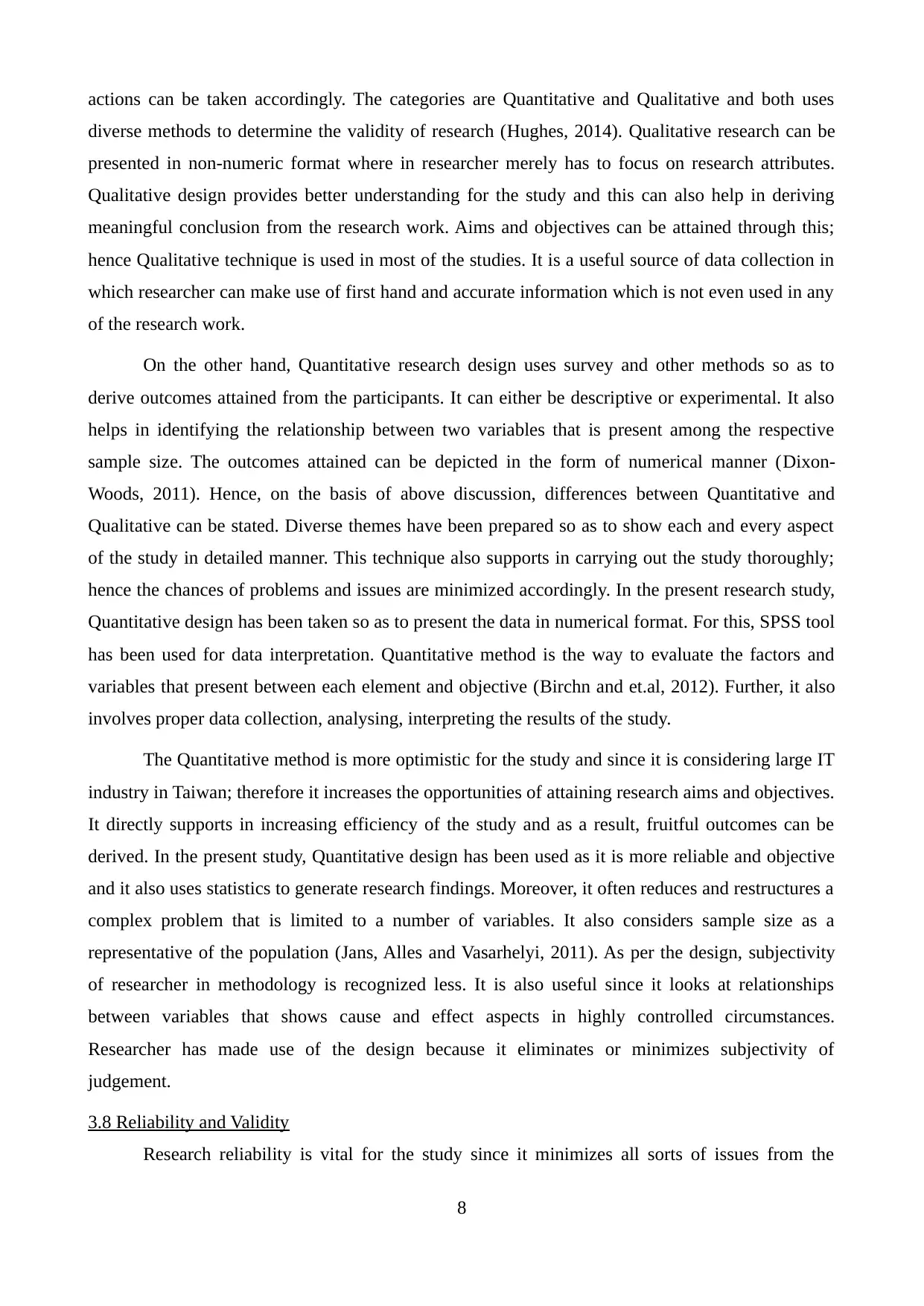
actions can be taken accordingly. The categories are Quantitative and Qualitative and both uses
diverse methods to determine the validity of research (Hughes, 2014). Qualitative research can be
presented in non-numeric format where in researcher merely has to focus on research attributes.
Qualitative design provides better understanding for the study and this can also help in deriving
meaningful conclusion from the research work. Aims and objectives can be attained through this;
hence Qualitative technique is used in most of the studies. It is a useful source of data collection in
which researcher can make use of first hand and accurate information which is not even used in any
of the research work.
On the other hand, Quantitative research design uses survey and other methods so as to
derive outcomes attained from the participants. It can either be descriptive or experimental. It also
helps in identifying the relationship between two variables that is present among the respective
sample size. The outcomes attained can be depicted in the form of numerical manner (Dixon-
Woods, 2011). Hence, on the basis of above discussion, differences between Quantitative and
Qualitative can be stated. Diverse themes have been prepared so as to show each and every aspect
of the study in detailed manner. This technique also supports in carrying out the study thoroughly;
hence the chances of problems and issues are minimized accordingly. In the present research study,
Quantitative design has been taken so as to present the data in numerical format. For this, SPSS tool
has been used for data interpretation. Quantitative method is the way to evaluate the factors and
variables that present between each element and objective (Birchn and et.al, 2012). Further, it also
involves proper data collection, analysing, interpreting the results of the study.
The Quantitative method is more optimistic for the study and since it is considering large IT
industry in Taiwan; therefore it increases the opportunities of attaining research aims and objectives.
It directly supports in increasing efficiency of the study and as a result, fruitful outcomes can be
derived. In the present study, Quantitative design has been used as it is more reliable and objective
and it also uses statistics to generate research findings. Moreover, it often reduces and restructures a
complex problem that is limited to a number of variables. It also considers sample size as a
representative of the population (Jans, Alles and Vasarhelyi, 2011). As per the design, subjectivity
of researcher in methodology is recognized less. It is also useful since it looks at relationships
between variables that shows cause and effect aspects in highly controlled circumstances.
Researcher has made use of the design because it eliminates or minimizes subjectivity of
judgement.
3.8 Reliability and Validity
Research reliability is vital for the study since it minimizes all sorts of issues from the
8
diverse methods to determine the validity of research (Hughes, 2014). Qualitative research can be
presented in non-numeric format where in researcher merely has to focus on research attributes.
Qualitative design provides better understanding for the study and this can also help in deriving
meaningful conclusion from the research work. Aims and objectives can be attained through this;
hence Qualitative technique is used in most of the studies. It is a useful source of data collection in
which researcher can make use of first hand and accurate information which is not even used in any
of the research work.
On the other hand, Quantitative research design uses survey and other methods so as to
derive outcomes attained from the participants. It can either be descriptive or experimental. It also
helps in identifying the relationship between two variables that is present among the respective
sample size. The outcomes attained can be depicted in the form of numerical manner (Dixon-
Woods, 2011). Hence, on the basis of above discussion, differences between Quantitative and
Qualitative can be stated. Diverse themes have been prepared so as to show each and every aspect
of the study in detailed manner. This technique also supports in carrying out the study thoroughly;
hence the chances of problems and issues are minimized accordingly. In the present research study,
Quantitative design has been taken so as to present the data in numerical format. For this, SPSS tool
has been used for data interpretation. Quantitative method is the way to evaluate the factors and
variables that present between each element and objective (Birchn and et.al, 2012). Further, it also
involves proper data collection, analysing, interpreting the results of the study.
The Quantitative method is more optimistic for the study and since it is considering large IT
industry in Taiwan; therefore it increases the opportunities of attaining research aims and objectives.
It directly supports in increasing efficiency of the study and as a result, fruitful outcomes can be
derived. In the present study, Quantitative design has been used as it is more reliable and objective
and it also uses statistics to generate research findings. Moreover, it often reduces and restructures a
complex problem that is limited to a number of variables. It also considers sample size as a
representative of the population (Jans, Alles and Vasarhelyi, 2011). As per the design, subjectivity
of researcher in methodology is recognized less. It is also useful since it looks at relationships
between variables that shows cause and effect aspects in highly controlled circumstances.
Researcher has made use of the design because it eliminates or minimizes subjectivity of
judgement.
3.8 Reliability and Validity
Research reliability is vital for the study since it minimizes all sorts of issues from the
8
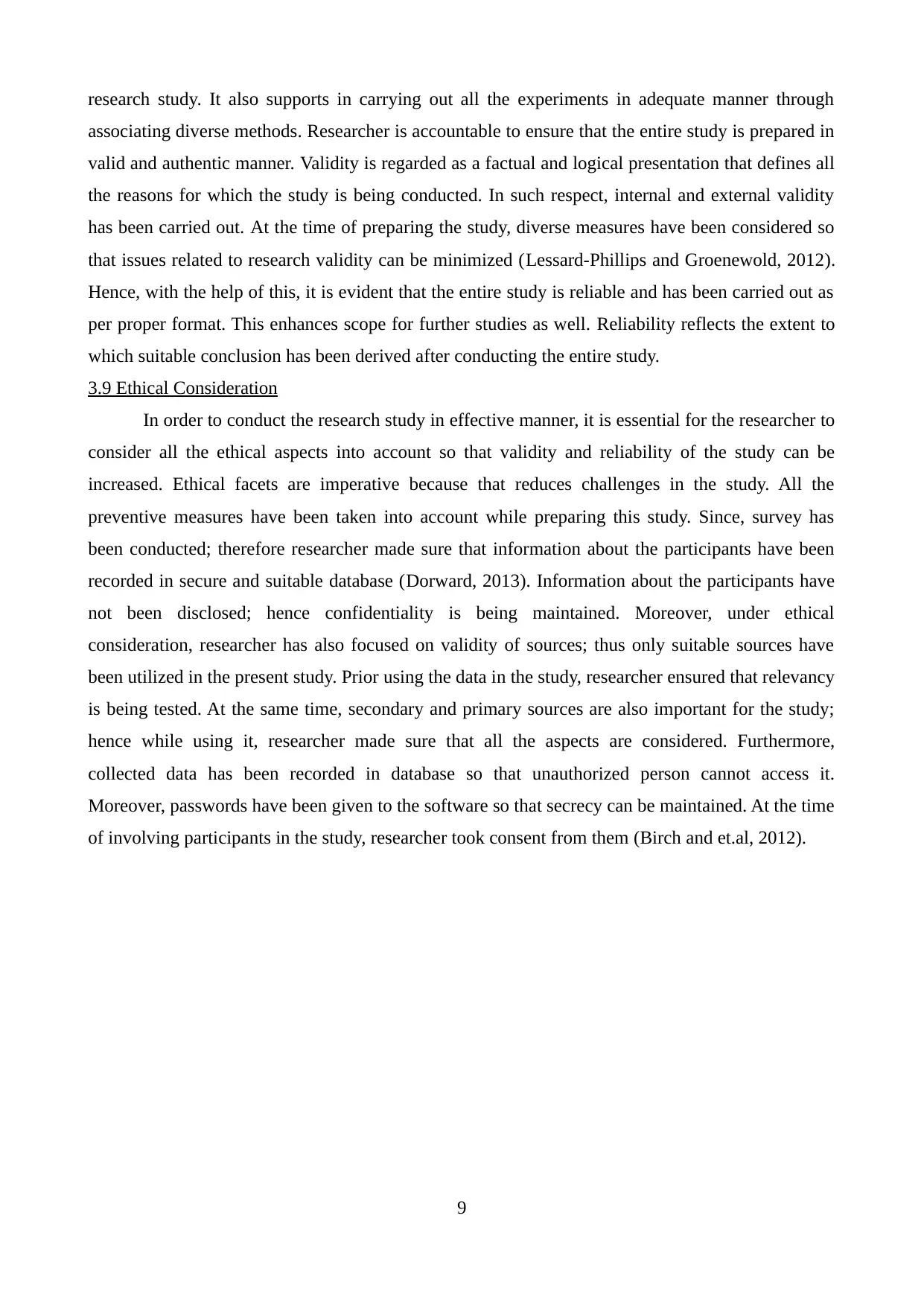
research study. It also supports in carrying out all the experiments in adequate manner through
associating diverse methods. Researcher is accountable to ensure that the entire study is prepared in
valid and authentic manner. Validity is regarded as a factual and logical presentation that defines all
the reasons for which the study is being conducted. In such respect, internal and external validity
has been carried out. At the time of preparing the study, diverse measures have been considered so
that issues related to research validity can be minimized (Lessard-Phillips and Groenewold, 2012).
Hence, with the help of this, it is evident that the entire study is reliable and has been carried out as
per proper format. This enhances scope for further studies as well. Reliability reflects the extent to
which suitable conclusion has been derived after conducting the entire study.
3.9 Ethical Consideration
In order to conduct the research study in effective manner, it is essential for the researcher to
consider all the ethical aspects into account so that validity and reliability of the study can be
increased. Ethical facets are imperative because that reduces challenges in the study. All the
preventive measures have been taken into account while preparing this study. Since, survey has
been conducted; therefore researcher made sure that information about the participants have been
recorded in secure and suitable database (Dorward, 2013). Information about the participants have
not been disclosed; hence confidentiality is being maintained. Moreover, under ethical
consideration, researcher has also focused on validity of sources; thus only suitable sources have
been utilized in the present study. Prior using the data in the study, researcher ensured that relevancy
is being tested. At the same time, secondary and primary sources are also important for the study;
hence while using it, researcher made sure that all the aspects are considered. Furthermore,
collected data has been recorded in database so that unauthorized person cannot access it.
Moreover, passwords have been given to the software so that secrecy can be maintained. At the time
of involving participants in the study, researcher took consent from them (Birch and et.al, 2012).
9
associating diverse methods. Researcher is accountable to ensure that the entire study is prepared in
valid and authentic manner. Validity is regarded as a factual and logical presentation that defines all
the reasons for which the study is being conducted. In such respect, internal and external validity
has been carried out. At the time of preparing the study, diverse measures have been considered so
that issues related to research validity can be minimized (Lessard-Phillips and Groenewold, 2012).
Hence, with the help of this, it is evident that the entire study is reliable and has been carried out as
per proper format. This enhances scope for further studies as well. Reliability reflects the extent to
which suitable conclusion has been derived after conducting the entire study.
3.9 Ethical Consideration
In order to conduct the research study in effective manner, it is essential for the researcher to
consider all the ethical aspects into account so that validity and reliability of the study can be
increased. Ethical facets are imperative because that reduces challenges in the study. All the
preventive measures have been taken into account while preparing this study. Since, survey has
been conducted; therefore researcher made sure that information about the participants have been
recorded in secure and suitable database (Dorward, 2013). Information about the participants have
not been disclosed; hence confidentiality is being maintained. Moreover, under ethical
consideration, researcher has also focused on validity of sources; thus only suitable sources have
been utilized in the present study. Prior using the data in the study, researcher ensured that relevancy
is being tested. At the same time, secondary and primary sources are also important for the study;
hence while using it, researcher made sure that all the aspects are considered. Furthermore,
collected data has been recorded in database so that unauthorized person cannot access it.
Moreover, passwords have been given to the software so that secrecy can be maintained. At the time
of involving participants in the study, researcher took consent from them (Birch and et.al, 2012).
9
⊘ This is a preview!⊘
Do you want full access?
Subscribe today to unlock all pages.

Trusted by 1+ million students worldwide
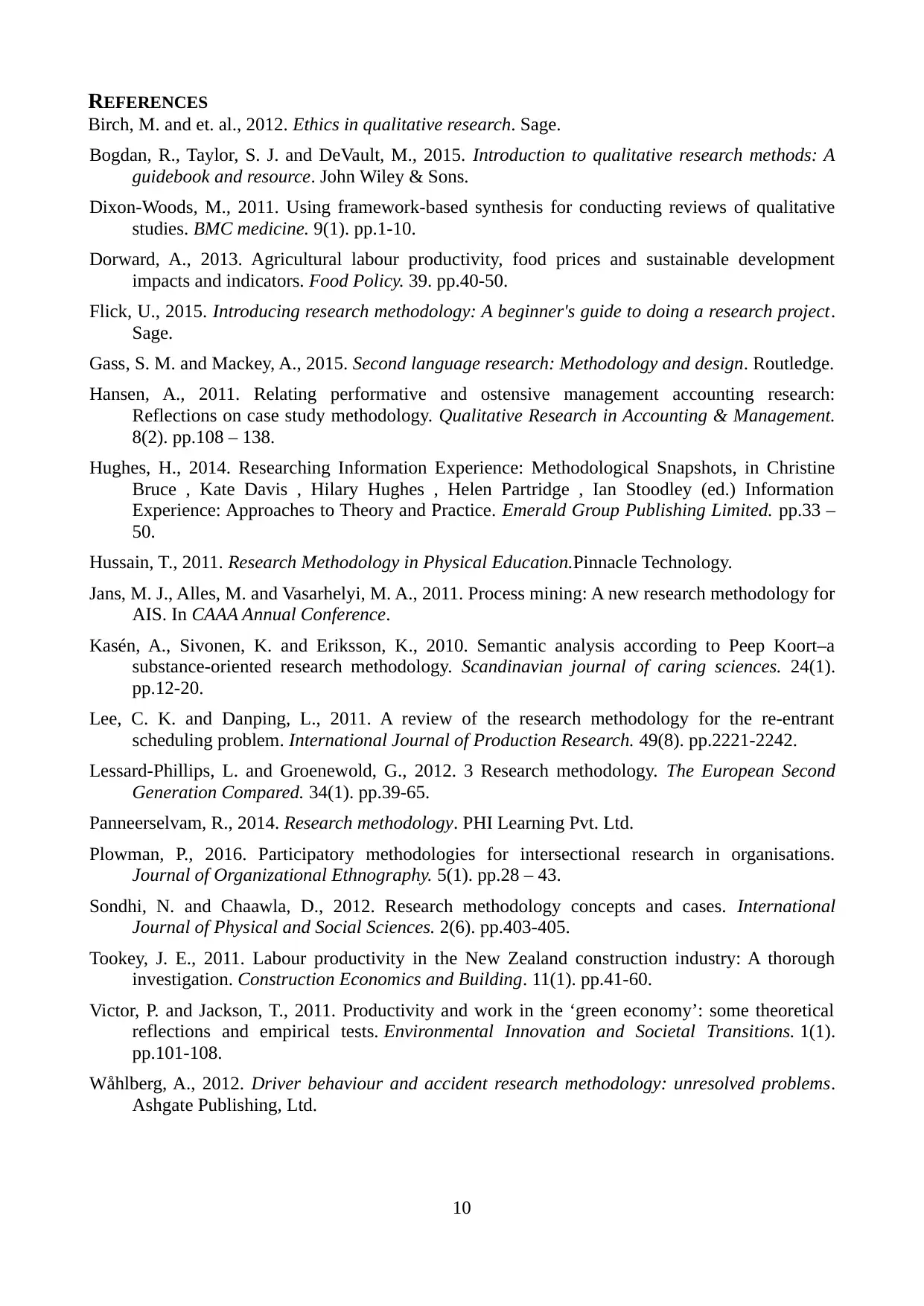
REFERENCES
Birch, M. and et. al., 2012. Ethics in qualitative research. Sage.
Bogdan, R., Taylor, S. J. and DeVault, M., 2015. Introduction to qualitative research methods: A
guidebook and resource. John Wiley & Sons.
Dixon-Woods, M., 2011. Using framework-based synthesis for conducting reviews of qualitative
studies. BMC medicine. 9(1). pp.1-10.
Dorward, A., 2013. Agricultural labour productivity, food prices and sustainable development
impacts and indicators. Food Policy. 39. pp.40-50.
Flick, U., 2015. Introducing research methodology: A beginner's guide to doing a research project.
Sage.
Gass, S. M. and Mackey, A., 2015. Second language research: Methodology and design. Routledge.
Hansen, A., 2011. Relating performative and ostensive management accounting research:
Reflections on case study methodology. Qualitative Research in Accounting & Management.
8(2). pp.108 – 138.
Hughes, H., 2014. Researching Information Experience: Methodological Snapshots, in Christine
Bruce , Kate Davis , Hilary Hughes , Helen Partridge , Ian Stoodley (ed.) Information
Experience: Approaches to Theory and Practice. Emerald Group Publishing Limited. pp.33 –
50.
Hussain, T., 2011. Research Methodology in Physical Education.Pinnacle Technology.
Jans, M. J., Alles, M. and Vasarhelyi, M. A., 2011. Process mining: A new research methodology for
AIS. In CAAA Annual Conference.
Kasén, A., Sivonen, K. and Eriksson, K., 2010. Semantic analysis according to Peep Koort–a
substance‐oriented research methodology. Scandinavian journal of caring sciences. 24(1).
pp.12-20.
Lee, C. K. and Danping, L., 2011. A review of the research methodology for the re-entrant
scheduling problem. International Journal of Production Research. 49(8). pp.2221-2242.
Lessard-Phillips, L. and Groenewold, G., 2012. 3 Research methodology. The European Second
Generation Compared. 34(1). pp.39-65.
Panneerselvam, R., 2014. Research methodology. PHI Learning Pvt. Ltd.
Plowman, P., 2016. Participatory methodologies for intersectional research in organisations.
Journal of Organizational Ethnography. 5(1). pp.28 – 43.
Sondhi, N. and Chaawla, D., 2012. Research methodology concepts and cases. International
Journal of Physical and Social Sciences. 2(6). pp.403-405.
Tookey, J. E., 2011. Labour productivity in the New Zealand construction industry: A thorough
investigation. Construction Economics and Building. 11(1). pp.41-60.
Victor, P. and Jackson, T., 2011. Productivity and work in the ‘green economy’: some theoretical
reflections and empirical tests. Environmental Innovation and Societal Transitions. 1(1).
pp.101-108.
Wåhlberg, A., 2012. Driver behaviour and accident research methodology: unresolved problems.
Ashgate Publishing, Ltd.
10
Birch, M. and et. al., 2012. Ethics in qualitative research. Sage.
Bogdan, R., Taylor, S. J. and DeVault, M., 2015. Introduction to qualitative research methods: A
guidebook and resource. John Wiley & Sons.
Dixon-Woods, M., 2011. Using framework-based synthesis for conducting reviews of qualitative
studies. BMC medicine. 9(1). pp.1-10.
Dorward, A., 2013. Agricultural labour productivity, food prices and sustainable development
impacts and indicators. Food Policy. 39. pp.40-50.
Flick, U., 2015. Introducing research methodology: A beginner's guide to doing a research project.
Sage.
Gass, S. M. and Mackey, A., 2015. Second language research: Methodology and design. Routledge.
Hansen, A., 2011. Relating performative and ostensive management accounting research:
Reflections on case study methodology. Qualitative Research in Accounting & Management.
8(2). pp.108 – 138.
Hughes, H., 2014. Researching Information Experience: Methodological Snapshots, in Christine
Bruce , Kate Davis , Hilary Hughes , Helen Partridge , Ian Stoodley (ed.) Information
Experience: Approaches to Theory and Practice. Emerald Group Publishing Limited. pp.33 –
50.
Hussain, T., 2011. Research Methodology in Physical Education.Pinnacle Technology.
Jans, M. J., Alles, M. and Vasarhelyi, M. A., 2011. Process mining: A new research methodology for
AIS. In CAAA Annual Conference.
Kasén, A., Sivonen, K. and Eriksson, K., 2010. Semantic analysis according to Peep Koort–a
substance‐oriented research methodology. Scandinavian journal of caring sciences. 24(1).
pp.12-20.
Lee, C. K. and Danping, L., 2011. A review of the research methodology for the re-entrant
scheduling problem. International Journal of Production Research. 49(8). pp.2221-2242.
Lessard-Phillips, L. and Groenewold, G., 2012. 3 Research methodology. The European Second
Generation Compared. 34(1). pp.39-65.
Panneerselvam, R., 2014. Research methodology. PHI Learning Pvt. Ltd.
Plowman, P., 2016. Participatory methodologies for intersectional research in organisations.
Journal of Organizational Ethnography. 5(1). pp.28 – 43.
Sondhi, N. and Chaawla, D., 2012. Research methodology concepts and cases. International
Journal of Physical and Social Sciences. 2(6). pp.403-405.
Tookey, J. E., 2011. Labour productivity in the New Zealand construction industry: A thorough
investigation. Construction Economics and Building. 11(1). pp.41-60.
Victor, P. and Jackson, T., 2011. Productivity and work in the ‘green economy’: some theoretical
reflections and empirical tests. Environmental Innovation and Societal Transitions. 1(1).
pp.101-108.
Wåhlberg, A., 2012. Driver behaviour and accident research methodology: unresolved problems.
Ashgate Publishing, Ltd.
10
1 out of 10
Related Documents
Your All-in-One AI-Powered Toolkit for Academic Success.
+13062052269
info@desklib.com
Available 24*7 on WhatsApp / Email
![[object Object]](/_next/static/media/star-bottom.7253800d.svg)
Unlock your academic potential
Copyright © 2020–2025 A2Z Services. All Rights Reserved. Developed and managed by ZUCOL.





